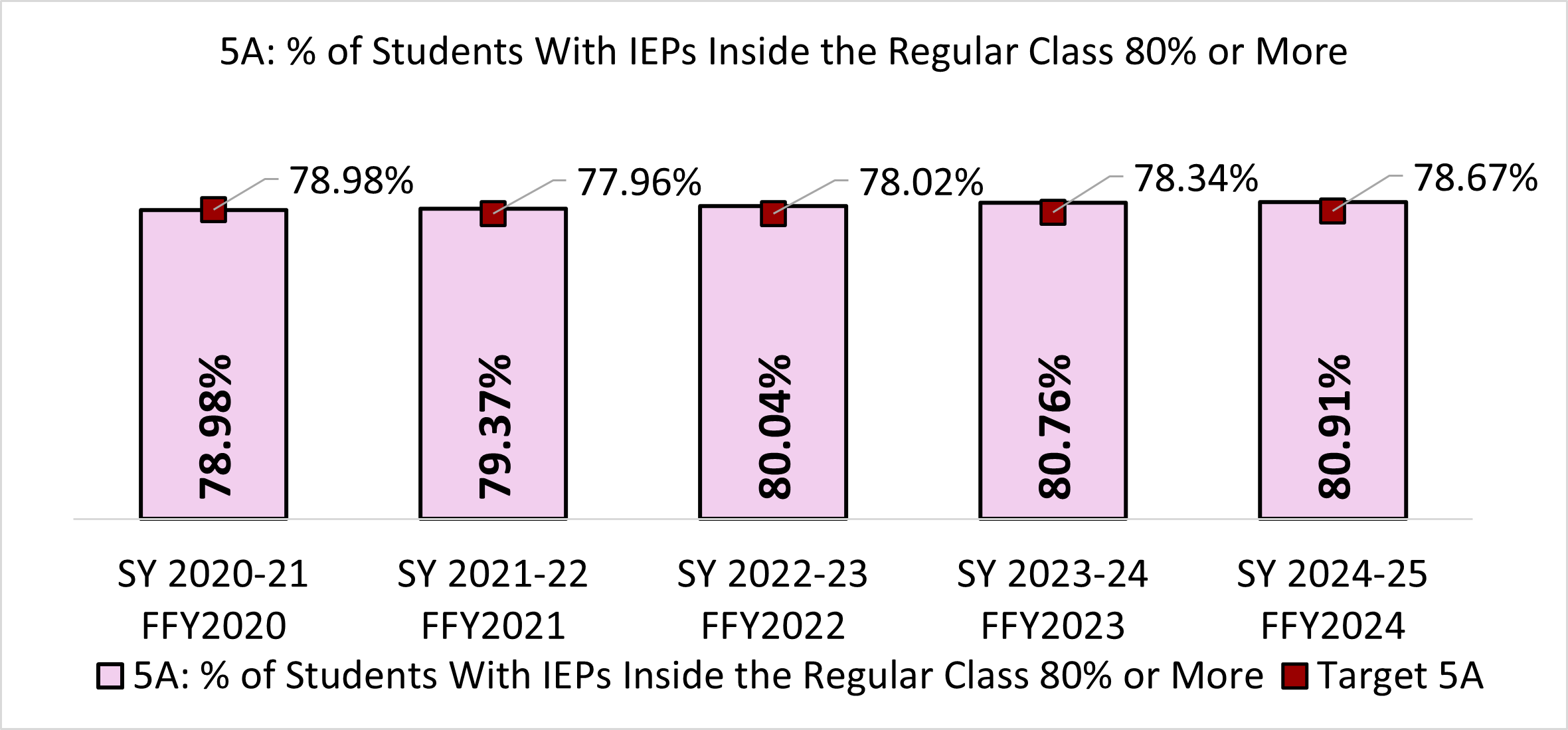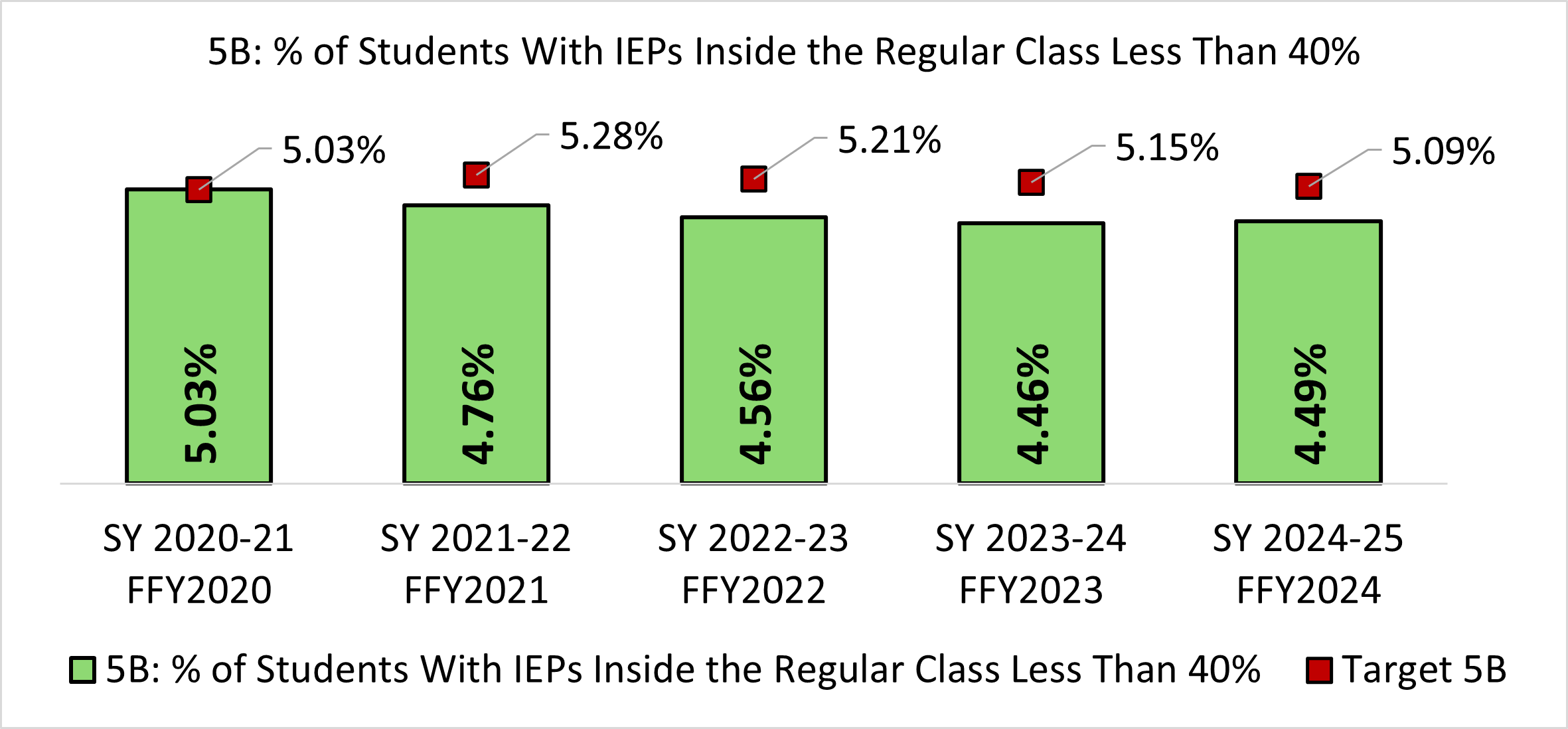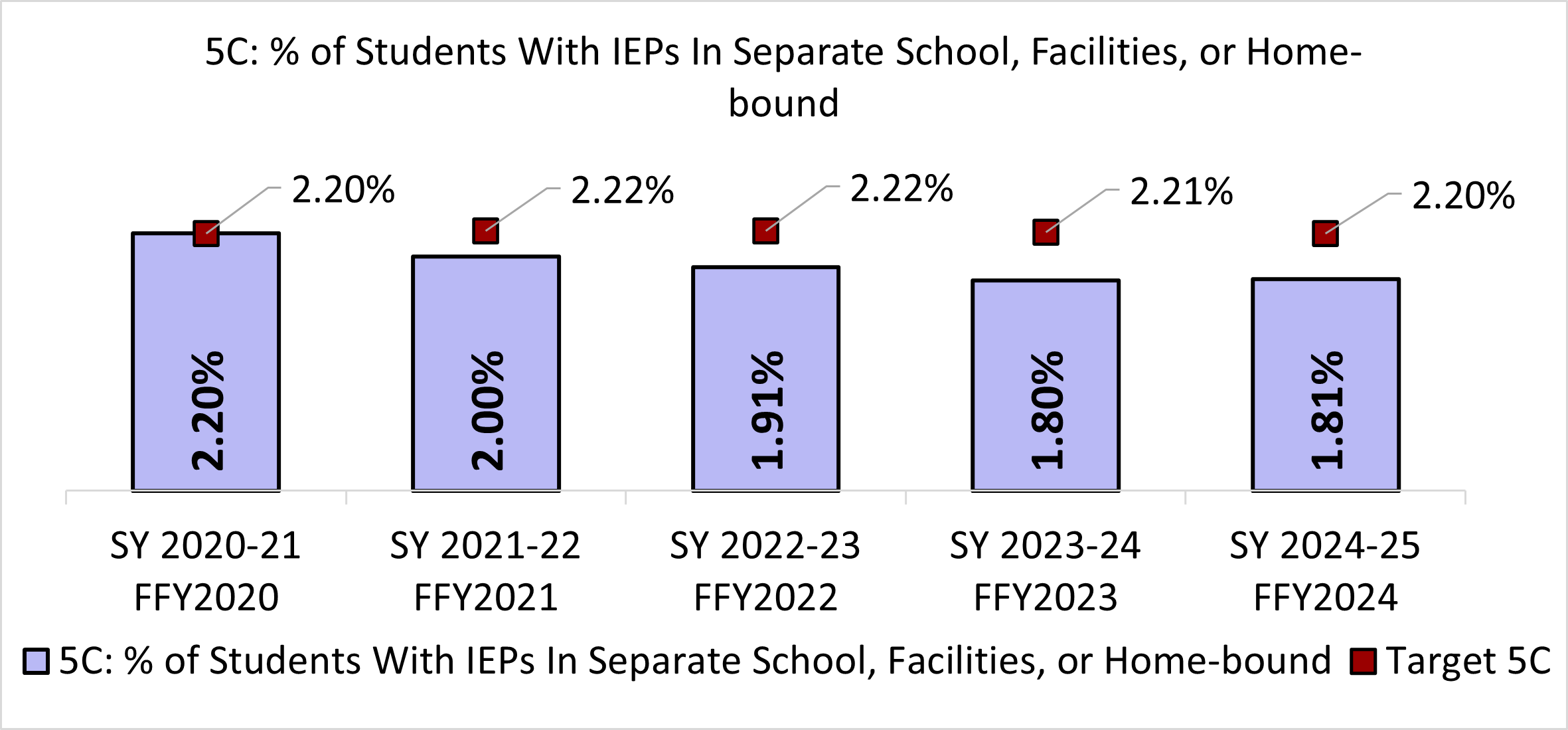You are here
Indicator 5 - Education Environment
Definition
Percentage of children with IEPs aged 5 (who are enrolled in kindergarten) through 21 served in the following settings:
- Indicator 5A. Inside the regular class 80% or more of the day.
- Indicator 5B. Inside the regular class less than 40% of the day.
- Indicator 5C. In separate schools, residential facilities, or home-bound/hospital placements.
States must report five-year-old children with disabilities who are enrolled in kindergarten in this indicator. Five-year-old children with disabilities who are enrolled in preschool programs are included in Indicator 6.
(20 U.S.C. 1416(a)(3)(A))
Measurement
Indicator 5A. Percent = [(# of children with IEPs aged 5 (who are enrolled in kindergarten) through 21 served inside the regular class 80% or more of the day) divided by the (total # of students aged 5 (who are enrolled in kindergarten) through 21 with IEPs)] times 100.
Indicator 5B. Percent = [(# of children with IEPs aged 5 (who are enrolled in kindergarten) through 21 served inside the regular class less than 40% of the day) divided by the (total # of students aged 5 (who are enrolled in kindergarten) through 21 with IEPs)] times 100.
Indicator 5C. Percent = [(# of children with IEPs aged 5 (who are enrolled in kindergarten) through 21 served in separate schools, residential facilities, or homebound/hospital placements) divided by the (total # of students aged 5 (who are enrolled in kindergarten) through 21 with IEPs)] times 100.
How is Colorado doing on this indicator?



Indicator 5 Results Table for the current SPP/APR Cycle
| School year and Federal Fiscal Year | SY 2020-21 FFY2020 | SY 2021-22 FFY2021 | SY 2022-23 FFY2022 | SY 2023-24 FFY2023 | SY 2024-25 FFY2024 |
| 5A: % of Students With IEPs Inside the Regular Class 80% or More | 78.98% | 79.37% | 80.04% | 80.76% | 80.91% |
| 5B: % of Students With IEPs Inside the Regular Class Less Than 40% | 5.03% | 4.76% | 4.56% | 4.46% | 4.49% |
| 5C: % of Students With IEPs In Separate School, Facilities, or Home-bound | 2.20% | 2.00% | 1.91% | 1.80% | 1.81% |
Targets for the Current SPP/APR Cycle
| Federal Fiscal Year (FFY) | 2020 | 2021 | 2022 | 2023 | 2024 | 2025 |
|---|---|---|---|---|---|---|
| Data from School Year | 2020-21 | 2021-22 | 2022-23 | 2023-24 | 2024-25 | 2025-26 |
| Target A >= | 78.98% | 77.69% | 78.02% | 78.34% | 78.67% | 78.99% |
| Target B <= | 5.03% | 5.28% | 5.21% | 5.15% | 5.09% | 5.02% |
| Target C <= | 2.20% | 2.22% | 2.22% | 2.21% | 2.20% | 2.19% |
Improvement strategies for Indicator 5
- CDE will develop a Facilitated Self-Assessment tool that includes guiding questions for AUs to use in examining LRE from a system-level perspective, as well as guiding questions at the individual student level when conducting IEP file reviews. (2021-2022)
- CDE will offer a state-wide book study on Comprehensive Literacy for All: Teaching Students with Significant Disabilities to Read and Write in Fall 2021. This book study will assist teachers with implementing a comprehensive literacy program for students with significant support needs in the least restrictive environment, challenging them to provide this programming in the general education setting.
- CDE will continue to build model sites for students with Significant Support Needs. This process includes utilizing the Quality Indicators for Assessing Individualized Services for Students (K-12) with Significant Support Needs tool. One of the domains that is evaluated through this process is inclusion.
- CDE will partner with the various National Deaf-Blind Federal Grant Project states to develop resources for meaningful inclusion of students who are deaf-blind.
- CDE offers a training on Social Emotion Learning and Mental Health Literacy which supports helping students stay in school and in the general education classroom.
- CDE offers a training on the Functional Behavior Assessments and Behavior Intervention Plans. When these tools are utilized, there are greater opportunities for students to continue to be successful in their schools and classrooms.
- CDE will provide training and mentor programming for educational interpreters to improve access to general education environments.
- CDE provides supports through Alternative Dispute Resolution training to districts regarding the understanding of the Individuals with Disabilities Education Act, including information regarding the least restrictive environment. The training, Improving IEP Teams: Skills for Resolving Conflict, has a section entitled “Knowing IDEA with Precision.”
- CDE provides Special Education Facilitators that support IEP meetings by ensuring all voices are heard and appropriate questions are asked, including information about services and the Least Restrictive Environment. Facilitation provides the opportunity for meaningful parent engagement, using visuals that lead to understanding and ultimately appropriate placement in the Least Restrictive Environment.
Additional Resources
- Target Setting Process Video for Indicator 5
For more information, contact:
Having trouble with this webpage?
If you have problems with broken links or accessing the content on this page, please contact the Exceptional Student Services Unit at ESSU@cde.state.co.us. Please copy the URL link for this page into the email when referencing the problem you are experiencing.



Connect With Us





